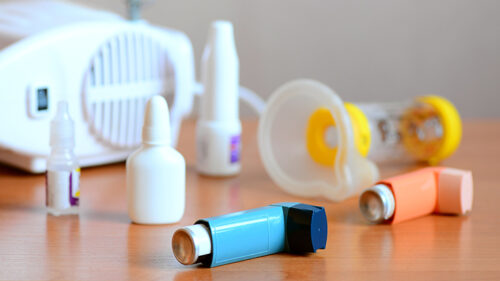
By Debbie Bunch
September 8, 2025
Neutrophilic Asthma Linked to Dietary Factors
Neutrophilic asthma is often harder to treat than allergic asthma because it is caused not by common environmental triggers but by microbial and bacterial proteins. Children with this type of asthma usually suffer from more severe disease and are more likely to end up in the hospital.
A study published by Science Translational Medicine suggests specific lipids found in foods associated with obesity may be playing a role, even in kids who are not obese.
Investigators from the Children’s Hospital of Philadelphia uncovered the link in a study conducted in a preclinical animal model that focused on lung macrophages. These specialized white blood cells coordinate immune function during inflammation.
When they looked at animals on a high-fat diet, they found that lung macrophages accumulated a saturated long-chain fatty acid called stearic acid, often found in animal fat and processed foods. Dietary stearic acid worsened airway inflammation without causing obesity.
The authors also found that the monounsaturated long-chain fatty acid known as oleic acid suppressed inflammatory activity, and that blocking the inflammatory cytokine IL-1β or inhibiting the protein IRE1⍺ — both of which are increased in neutrophilic asthma — protected against stearic acid-driven lung inflammation.
The researchers went on to confirm some of these findings in humans by looking for the markers in bronchoalveolar lavage fluid taken from patients with obesity-associated asthma.
“While there are many risk factors and triggers that are associated with asthma, this study provides evidence about how specific dietary components are linked to a particularly difficult-to-treat form of asthma,” said study co-author Lisa Young, MD. “These findings are encouraging because they provide new treatment strategies and suggest that targeted dietary modifications may help prevent this asthma type.” Read Press Release Read Abstract

Older Teens Become Addicted to Vaping Sooner than Younger Teens
In a study conducted among 2,291 teenagers in California high schools who were in the ninth grade when the study began in 2014, researchers from the University of Southern California found that teens who waited until after high school graduation to try vaping for the first time progressed to regular vaping the fastest.
The students were surveyed every six months while in high school and once a year thereafter until 2023 to gauge their vaping status. The investigators divided them into four groups based on when they began vaping and whether they progressed to frequent use, defined as using e-cigarettes on 20 out of 30 days a month.
About 21% of the students fell into the young adulthood/rapid progression group, progressing to frequent use within an average of 1.2 years.
Students in this group were also more likely to report their first experience with vaping was with JUUL products, which were widely available during the 2018-2019 period when they would have been graduating, and are considered more addictive than other vaping products.
By comparison, 14% of participants in the early high school/gradual progression group progressed to frequent use within three years, or 40% slower than those in the young adulthood/rapid progression group. The exact time frame to progression applied to the 4% of students in the late high school/gradual progression group.
The other students in the study, making up 60% of the total, were in the low initiation risk/no progression group, meaning they had a low risk of starting to vape and not becoming addicted to it if they did try it.
The authors wrote, “Although prior research has suggested early e-cigarette use initiators are at high risk, this study identified an additional unique profile of late use initiation and rapid progression to frequent use . . . highlighting the significance of targeting this group for e-cigarette regulations.”
The study was published in Addiction. Read Article Read Full Paper

Metals and Sulfate Particles in PM2.5 Most Likely to Contribute to Asthma Hospitalizations
According to researchers from the Harvard T.H. Chan School of Public Health, the metals and sulfate particles contained in fine particulate air pollution (PM2.5) are most likely to be associated with hospitalization in asthma patients.
In a study published by the American Journal of Respiratory and Critical Care Medicine, they used data from previous studies and machine learning algorithms to identify 15 metals and organic compounds comprising PM2.5 pollution, including bromine, calcium, copper, elemental carbon, iron, potassium, ammonium, nickel, nitrate, organic carbon, lead, silicon, sulfate, vanadium, and zinc.
Additional machine learning algorithms were then employed to produce annual estimates of each compound at a U.S. zip code level. State inpatient databases were used to project asthma hospitalizations in 11 states between 2002 and 2016.
After controlling for other factors that could influence hospitalization for asthma, such as outdoor temperature and socioeconomic status, they found that for each decile increase in the pollutant mixture, asthma hospitalizations increased 10.6% among children and 8% among adults ages 19 to 64.
Nickel, vanadium, sulfate, nitrate, bromine, and ammonium contributed the most weight to the association found between PM2.5 and asthma hospitalization.
“We know that PM2.5 increases the risk of asthma attacks and hospitalizations, but those particles are made of many compounds, and we haven’t known which are most harmful,” said study author Joel Schwartz. “Our study teases out which specific compounds in the PM2.5 mixture necessitate the strongest control efforts to improve asthma outcomes.” Read Press Release Read Abstract







